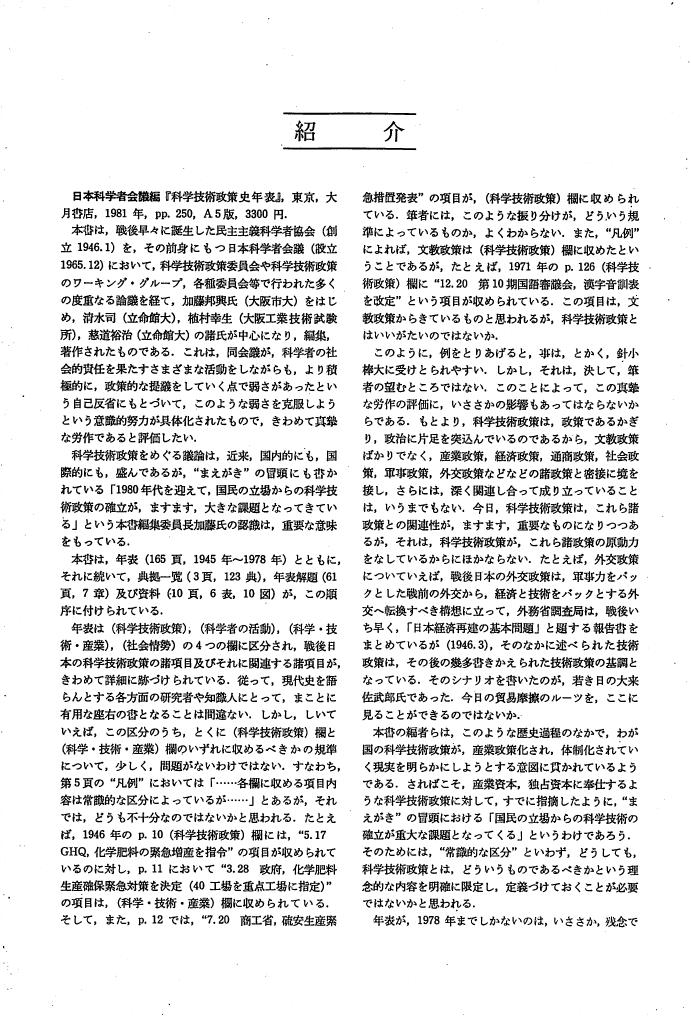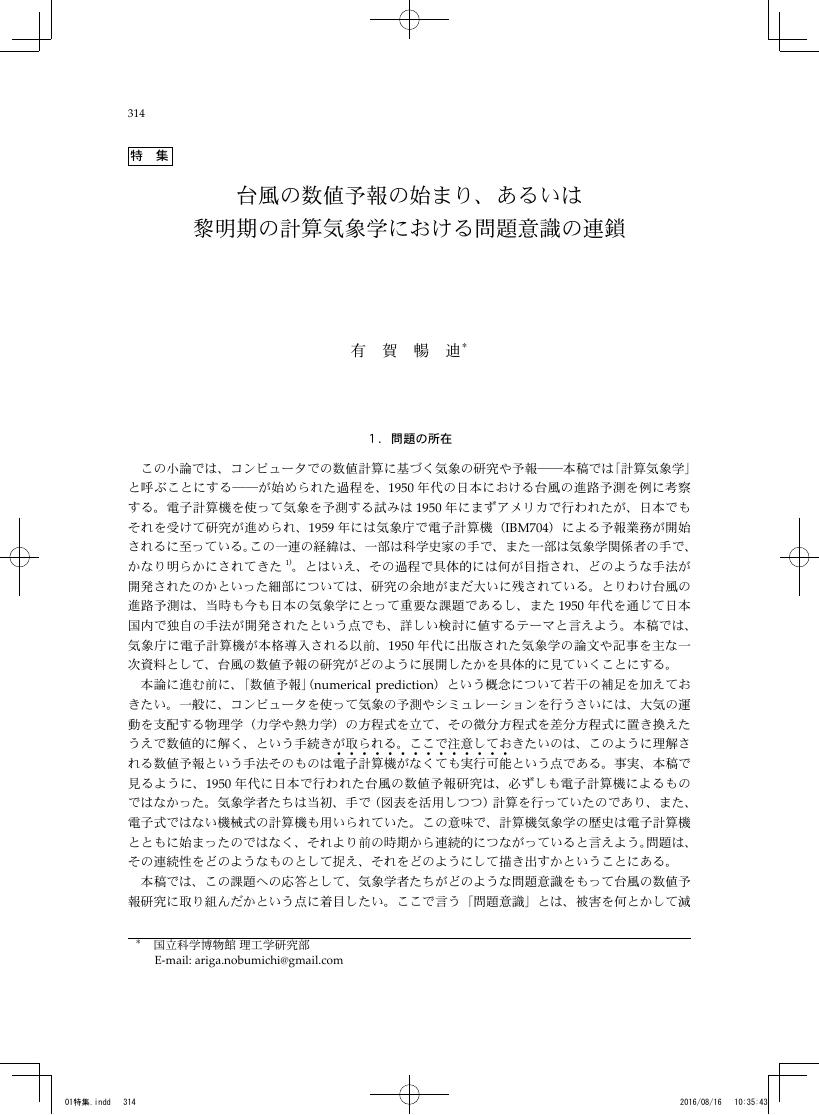1 0 0 0 OA 書評・紹介
- 出版者
- 日本科学史学会
- 雑誌
- 科学史研究 (ISSN:21887535)
- 巻号頁・発行日
- vol.21, no.143, pp.176-181, 1982 (Released:2021-04-08)
1 0 0 0 OA 書評・紹介
- 出版者
- 日本科学史学会
- 雑誌
- 科学史研究 (ISSN:21887535)
- 巻号頁・発行日
- vol.21, no.141, pp.59-63, 1982 (Released:2021-05-13)
1 0 0 0 OA 書評・紹介
- 出版者
- 日本科学史学会
- 雑誌
- 科学史研究 (ISSN:21887535)
- 巻号頁・発行日
- vol.21, no.142, pp.120-125, 1982 (Released:2021-05-13)
1 0 0 0 OA 書評・紹介
- 出版者
- 日本科学史学会
- 雑誌
- 科学史研究 (ISSN:21887535)
- 巻号頁・発行日
- vol.23, no.152, pp.238-245, 1984 (Released:2021-04-07)
1 0 0 0 OA 書評・紹介
- 出版者
- 日本科学史学会
- 雑誌
- 科学史研究 (ISSN:21887535)
- 巻号頁・発行日
- vol.23, no.151, pp.184, 1984 (Released:2021-04-07)
1 0 0 0 OA 書評・紹介
- 出版者
- 日本科学史学会
- 雑誌
- 科学史研究 (ISSN:21887535)
- 巻号頁・発行日
- vol.24, no.156, pp.244-246, 1985 (Released:2021-04-05)
1 0 0 0 OA 書評・紹介
- 出版者
- 日本科学史学会
- 雑誌
- 科学史研究 (ISSN:21887535)
- 巻号頁・発行日
- vol.24, no.153, pp.40-59, 1985 (Released:2021-04-07)
1 0 0 0 OA 書評・紹介
- 出版者
- 日本科学史学会
- 雑誌
- 科学史研究 (ISSN:21887535)
- 巻号頁・発行日
- vol.24, no.155, pp.184, 1985 (Released:2021-04-07)
1 0 0 0 OA 書評・紹介
- 出版者
- 日本科学史学会
- 雑誌
- 科学史研究 (ISSN:21887535)
- 巻号頁・発行日
- vol.24, no.154, pp.120-126, 1985 (Released:2021-04-07)
1 0 0 0 OA 書評・紹介
- 出版者
- 日本科学史学会
- 雑誌
- 科学史研究 (ISSN:21887535)
- 巻号頁・発行日
- vol.25, no.157, pp.53-62, 1986 (Released:2021-04-05)
1 0 0 0 OA 書評・紹介
- 出版者
- 日本科学史学会
- 雑誌
- 科学史研究 (ISSN:21887535)
- 巻号頁・発行日
- vol.60, no.297, pp.78-82, 2020 (Released:2021-10-06)
1 0 0 0 OA 書評・紹介
- 出版者
- 日本科学史学会
- 雑誌
- 科学史研究 (ISSN:21887535)
- 巻号頁・発行日
- vol.60, no.298, pp.187-191, 2021 (Released:2022-08-01)
1 0 0 0 OA 書評・紹介
- 出版者
- 日本科学史学会
- 雑誌
- 科学史研究 (ISSN:21887535)
- 巻号頁・発行日
- vol.21, no.144, pp.210-222, 1982 (Released:2021-04-08)
- 著者
- 山中 千尋
- 出版者
- 日本科学史学会
- 雑誌
- 科学史研究 (ISSN:21887535)
- 巻号頁・発行日
- vol.55, no.277, pp.35, 2016 (Released:2021-01-05)
- 著者
- 大石 和江 竹内 伸
- 出版者
- 日本科学史学会
- 雑誌
- 科学史研究 (ISSN:21887535)
- 巻号頁・発行日
- vol.54, no.275, pp.248, 2015 (Released:2020-12-14)
1 0 0 0 平田先生を悼む
- 著者
- 菊池 俊彦
- 出版者
- 日本科学史学会
- 雑誌
- 科学史研究 (ISSN:21887535)
- 巻号頁・発行日
- vol.32, no.188, pp.236-238, 1993
1 0 0 0 小特集 渋川春海没後300周年 : 渋川春海研究の新展開に向けて
- 著者
- 中村 士 吉田 忠
- 出版者
- 日本科学史学会
- 雑誌
- 科学史研究 (ISSN:21887535)
- 巻号頁・発行日
- vol.54, no.276, 2016
- 著者
- 有賀 暢迪
- 出版者
- 日本科学史学会
- 雑誌
- 科学史研究 (ISSN:21887535)
- 巻号頁・発行日
- vol.54, no.276, pp.314, 2016 (Released:2021-01-05)
- 著者
- 山崎 正勝
- 出版者
- 日本科学史学会
- 雑誌
- 科学史研究 (ISSN:21887535)
- 巻号頁・発行日
- vol.53, no.270, pp.199, 2014 (Released:2020-12-09)
Japan and the United States signed in 1968 a new atomic energy agreement through which US light-water nuclear reactors, including those of the Fukushima Daiichi Nuclear Power Plant of Tokyo Electric Power Company, were to be introduced into Japan. This paper studies the history of negotiations for the 1968 agreement using documents declassified in the 1990s in the US and Japan. After the success of the Chinese nuclear test in October 1964, the United States became seriously concerned about nuclear armament of other countries in Asia including Japan. Expecting that Japan would not have its own nuclear weapons, the US offered to help the country to demonstrate its superiority in some fields of science including peaceful nuclear energy to counter the psychological effect of the Chinese nuclear armament. Driven by his own political agenda, the newly appointed Prime Minister Eisaku Sato responded to the US expectation favorably. When he met in January 1965 with President Johnson, Sato made it clear that Japan would not pursue nuclear weapons. Although the US continued its support after this visit, it nevertheless gave priority to the control of nuclear technology in Japan through the bilateral peaceful nuclear agreement. This paper argues that the 1968 agreement implicitly meant a strategic measure to prevent Japan from going nuclear and also a tactic to persuade Japan to join the Nuclear Non -Proliferation Treaty.
1 0 0 0 幕末期における蒸気船運転と蒸気機関 : 加賀藩の発機丸を事例に
- 著者
- 坂本 卓也
- 出版者
- 日本科学史学会
- 雑誌
- 科学史研究 (ISSN:21887535)
- 巻号頁・発行日
- vol.59, no.294, pp.131-148, 2020
The author will clarify the engine operation and its specifications of Hakki-Maru of Kaga clan that was the steamship introduced to Japan at the end of the Tokugawa period. Hakki-Maru was propelled by sails and a steam engine on Japanʼs coastline. The engine operation was relatively smooth under the calm weather, but some steam leaks of the boiler occurred mainly at the stormy weather. Though the boiler of Hakki-Maru was designed to generate steam pressures of 60 psi., the steam pressure was frequently less than 1/4 of the maximum working pressure. The repair of the engine required the help of a Shogunate engineer with a lot of operating experience. Hakki-Maru built in the United Kingdom and was equipped with a compound engine. Also it is highly probable that a combination of cylindrical boiler and surface condenser was equipped. These were developed to improve the efficiency of the engine but had been just put into practical use. The frequent breakdowns at Hakki-Maru were due to the installation of the latest equipment that required careful operation and maintenance. The steamship sold to Japan at the end of the Tokugawa period included not only old ones but also new one equipped with some cutting-edge technology. Since the steamship itself was the means of transportation, the latest technology onboard could quickly spread to the distant locations.
















